Palm Trees in Harrisonburg: Space Conditioning, Inc.

For each issue of the Quarterly Newsletter, we strive to find exceptional cover images that will delight, astonish, or simply be appreciated by Rocktown History members. In many cases, the images pop up throughout the preceding months from recent donations of artifacts and archives. We know it when we see it! Sometimes, we struggle to meet our own expectations or are limited by the requirements of the 8.5 x 11″ portrait format, but that is often when serendipity steps in.
The Summer 2025 issue of the Newsletter didn’t have a cover until close to press time. Curator Scott Suter and I were combing through recent collections when we opened a small envelope waiting to be processed in the archives. Inside, we discovered snapshots of an event that included a palm tree! What evokes hot and sunny days more than a palm tree? We had discovered a series of photos from the dedication of Harrisonburg’s Space Conditioning, Inc, manufacturing plant in 1965. Palm trees in Harrisonburg sixty years ago? We found our cover shot, but had no room for an article—a blessing since the blog allows for more story and photos!
On June 30, 2025, on a plot of land along Interstate 81 at the Mount Crawford exit, Virginia’s first Buc-ee’s gas station/shopping destination extraordinaire was dedicated. Virginia Governor Glenn Youngkin and other local dignitaries joined Buc-ee’s owner and founder Arch “Beaver” Aplin III to celebrate the occasion. Thousands of people streamed in from near and far (including Delaware!) to take part in the grand opening.
Predictions for the economic impact of the chain’s widely-popular brisket, bathrooms, gas pumps, and charging stations indicate Rockingham County will benefit from $1-2 million in meals tax revenue. In and around Harrisonburg and Rockingham, Buc-ee’s-branded t-shirts and hats are popping up as visible proof of consumer support.
Whether you align with the fans or the detractors, it’s undeniable that the Buc-ee’s project was a substantial notch in Rockingham County’s economic development portfolio.
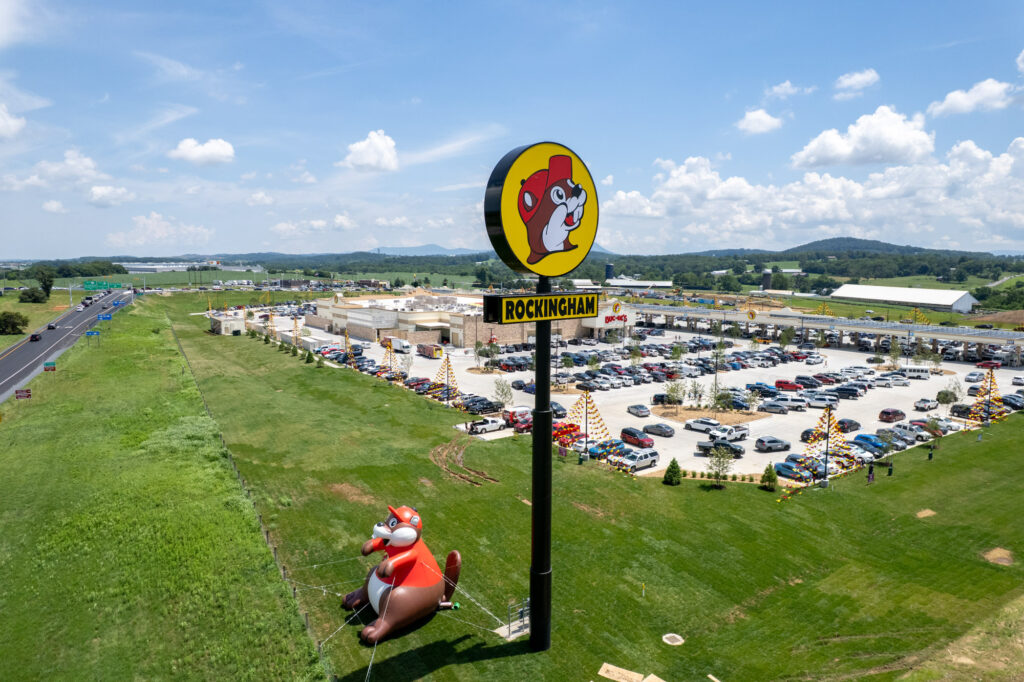

Attracting new industry to the area is not a new concept. In the 1950s, local agriculture production was booming. Community leaders, concerned about putting all the eggs in one basket, created the Rockingham Development Corporation and began pursuing a diversified industrial base.
Sixty years ago, and about seven miles north, a dedication event similar to this summer’s Buc-ee’s celebration took place, minus the brisket and t-shirts.
In 1963, the Daily News-Record published this map announcing the plans of Electronic Specialty Company, a Los Angeles firm, to build a new plant in Harrisonburg along the relatively new Interstate 81. The land parcel shown is 40 acres, and the company had purchased another 35 acres to the south for future growth. By comparison, Buc-ees’ parcel is 21.3 acres.
Electronic Specialty was a rapidly-growing and highly-diversified corporation in electromechanical fields which contributed to projects of NASA, Boeing, and McDonnell, among others on land and sea.
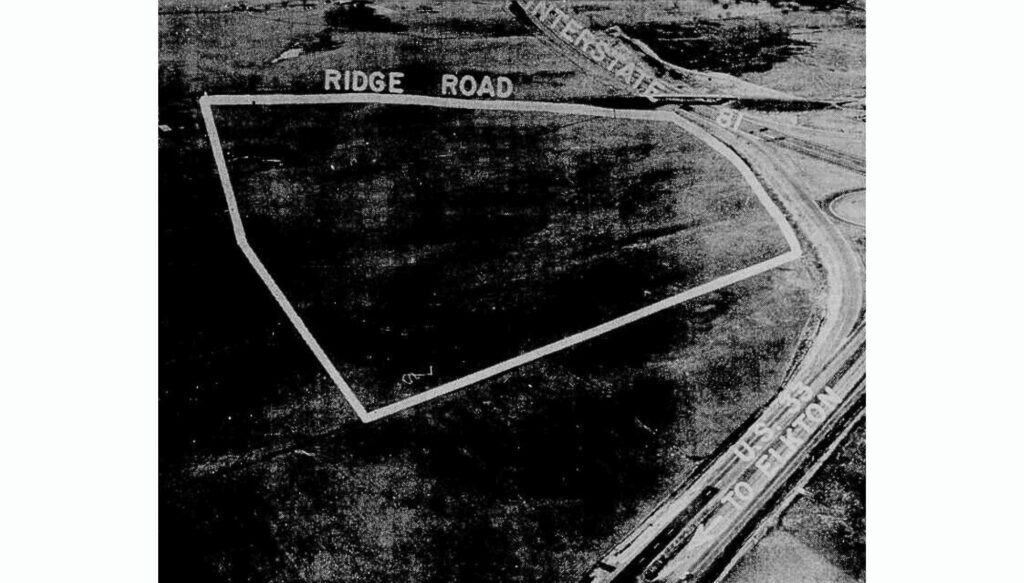
In anticipation of the plant opening, the State Department of Education initiated an industrial training program to be carried out by the Rockingham County and Harrisonburg school systems in order to prepare 500 men for manufacturing work. The site development required construction of a new road on a right-of-way from Ridge Road (current Reservoir St) to Route 33. Evidence of the road is seen in this aerial image.
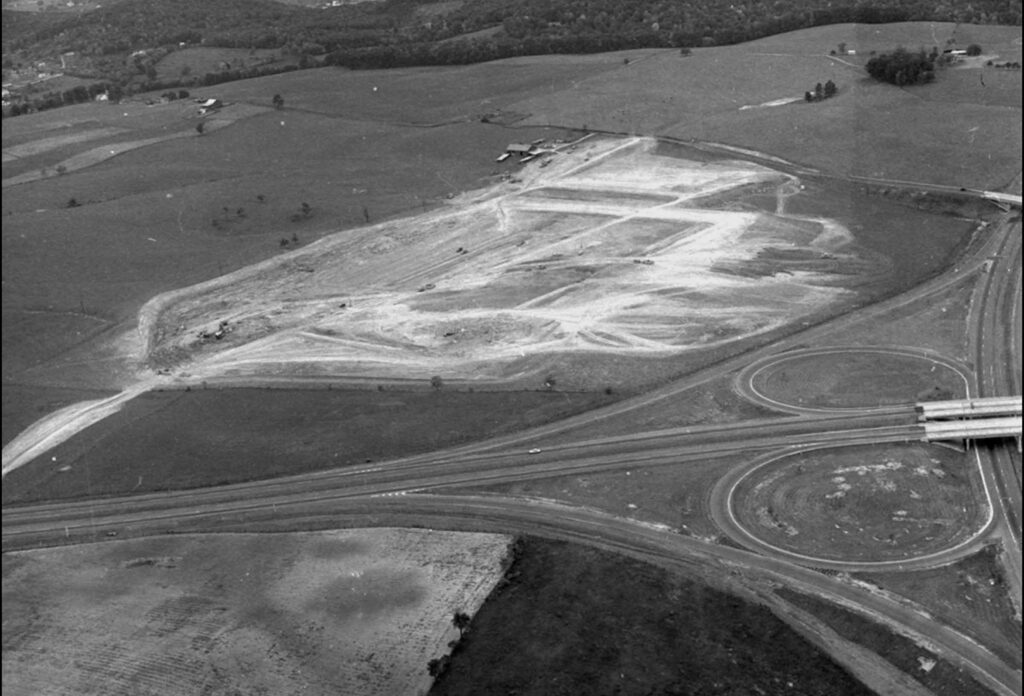
Other necessary preparation included providing water, sewer, and electric utilities to the site. This project required the cooperation of Harrisonburg and Rockingham government and community, Virginia agencies, Virginia Electric and Power, plus the Chesapeake & Western and Norfolk & Western railways. Even the Shenandoah Valley Airport in Weyers Cave was critical to the success of the new venture.
When the new Space Conditioning Inc. plant opened on May 14, 1965, the Daily News-Record gave full coverage to the event. As with the Buc-ee’s opening, Virginia’s governor, then Albertis S. Harrison, and other noted officials were on hand to welcome Electronic Specialty President William Burgess and his family.
Mayor Frank Switzer and Rockingham County Supervisors kicked off events at the Harrisonburg Court House by proclaiming “Space Conditioning Day” and thanking everyone involved for making the project a reality.
Afterwards, a motorcade drove out to the Space Conditioning site. Harrisonburg High School’s band added to the festive air, as 1,000 employees and special guests from across the country filled seats and bleachers under and around the entrance colonnade.
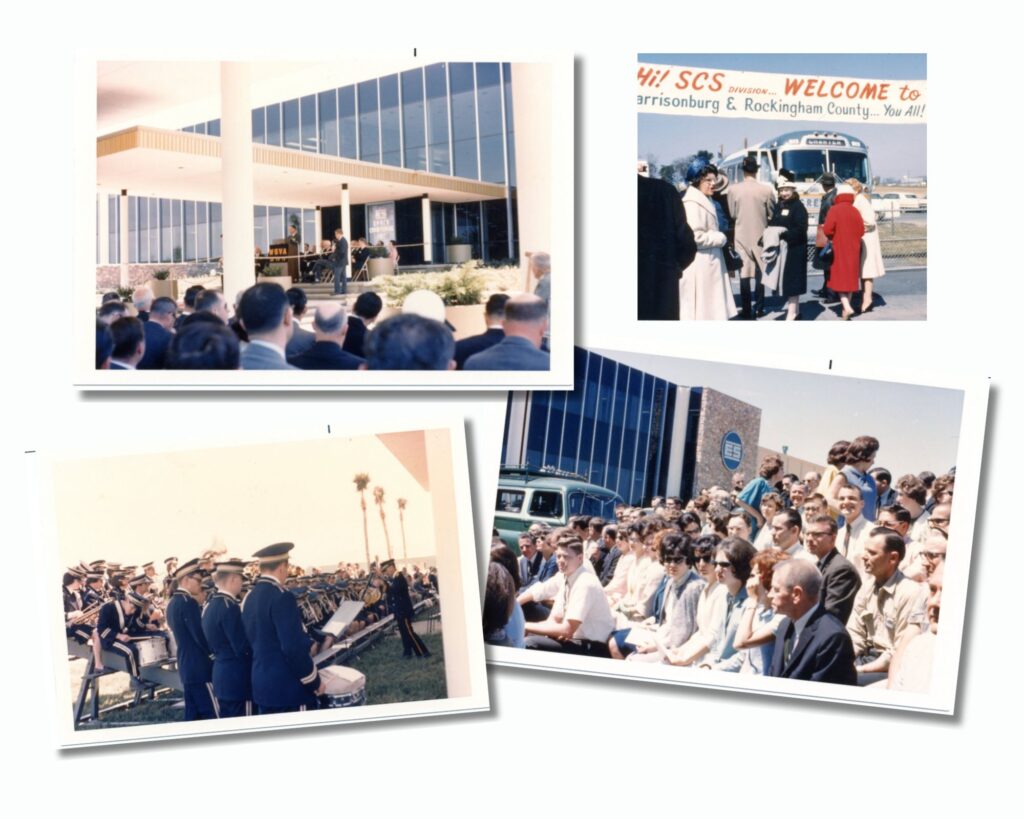
Skydivers arrived with a special key for President Burgess to present to the Governor.
Secretary to the plant manager and Space Conditioning’s first Virginia employee Hetty Wagner cut the ribbon.

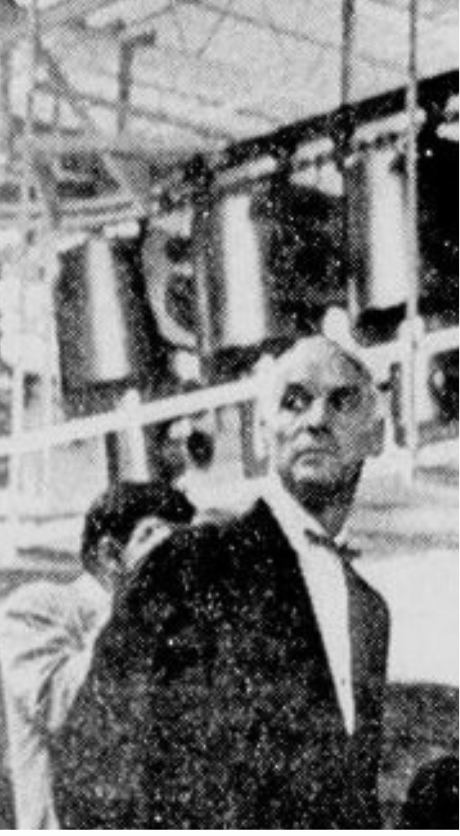
President William Burgess

and Hetty Wagner
The plant was open to public tours for two days. While Buc-ee’s is noted for a building the size of a football field, Space Conditioning’s facility was at least nine times the size. The façade of the building was graced by a glass curtain wall 25’ high by 360’ wide. Six 32’ high palm trees symbolized the California headquarters of its parent company.
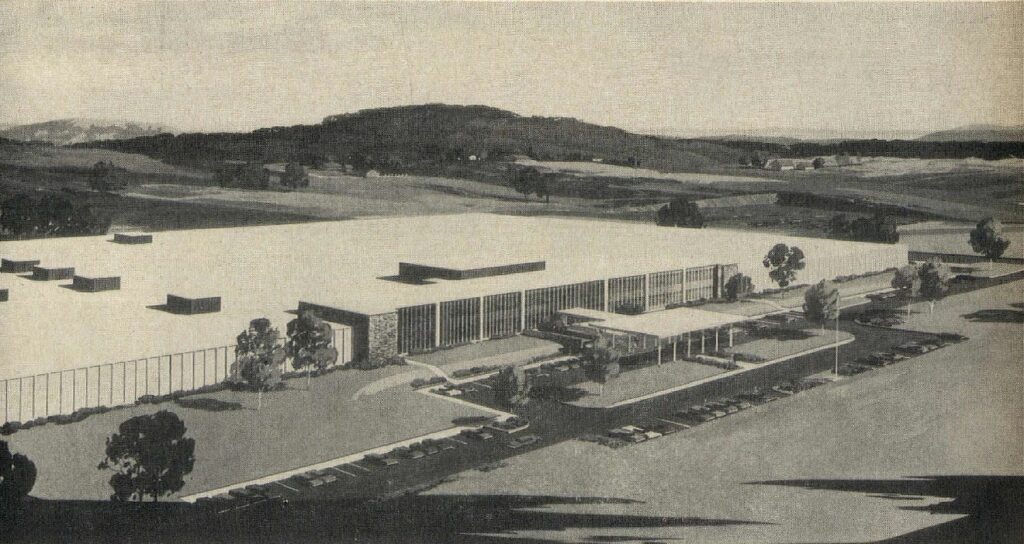

Space Conditioning, Inc., was developed for the integrated manufacture of indoor climate control and the ultra-modern plant served as a showroom for its products. Six Electronics Specialty companies were consolidated at the site. Local contractors and businesses from Harrisonburg involved in the Space Conditioning plant construction included architects D’Earcy P. Davis, Jr. and Clyde McClintock, Nielsen Construction (as one-half of the Shen-Valley Corp. contracting team), Betts & Frazier, Inc, Frazier Quarry, Union Roofing of Virginia Inc., Valley Concrete Products Corp., Dan L. Logan, Heatwole Tile Co., and C. G. Price & Sons.
Electronics Specialty sold Space Conditioning to Signal Companies of California in 1968. In 1969, Signal merged Space Conditioning with Dunham-Bush, which closed its plant in Michigan. The Harrisonburg location was later rebranded to Dunham-Bush. The plant closed in 2002, in large part due to the economic aftershocks of September 11, 2001. During demolition in 2003, as much as 95% of the site’s materials were salvaged and recycled during the construction of the Harrisonburg Crossing shopping center that stands on the site today.
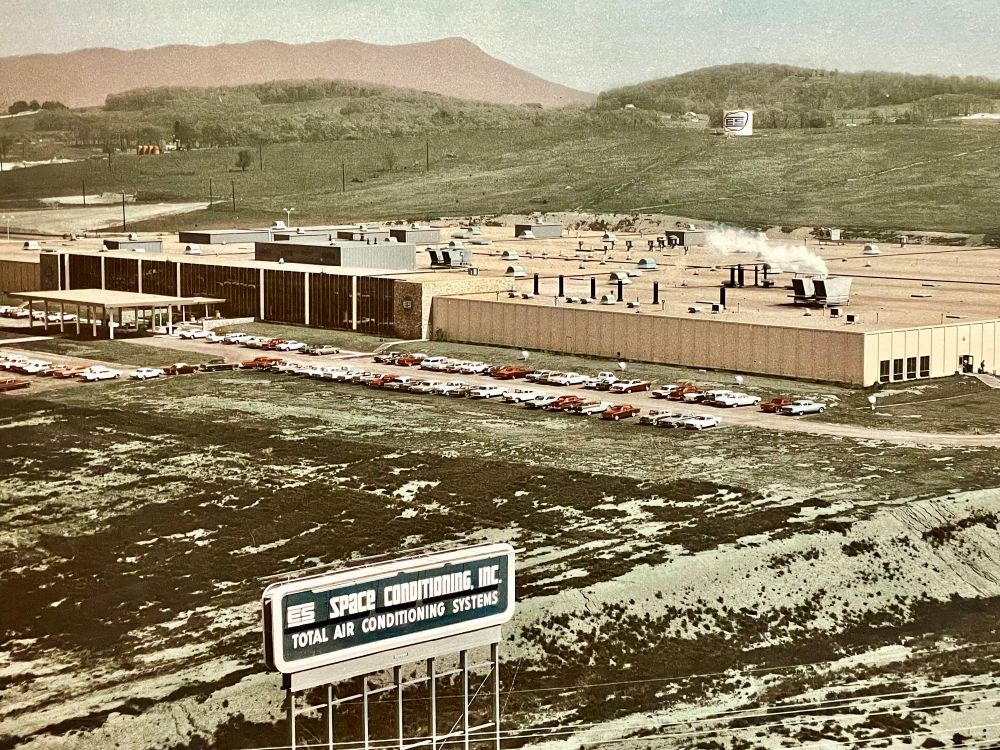
About those palm trees . . .
As mentioned, six palms stood tall to represent the California home state of parent company Electronics Specialty. Local skinny suggests the addition of the palms was also a opportunity for Space Conditioning to show off its climate control talents.
To survive the Virginia winter, heated plastic tenting was erected around the trees. The structures were no match for Mother Nature—two trees (and their shelters) were blown down by strong winds within six months.
right: Palm tree stands tall on May 14, 1965.
far right: Toppled palm tree and tent in foreground, Daily News-Record, November 29, 1965.

Side(street) Note:

Remember that new connector road? Prior to the dedication event, Mrs. Burgess and her daughters unveiled a new street sign. Canny local readers will have already guessed the name . . . Burgess Road, in honor of Electronics Specialty President William Burgess.
left, Clara Burgess and daughters Sarah and Molly at the unveiling.
